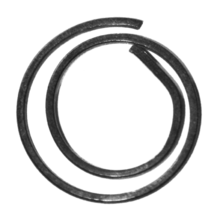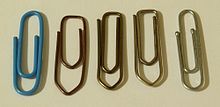Paper clip

A letter clip or paper clip is an auxiliary item in the office that is used to releasably attach several sheets of paper to one another. Paper clips are usually made of bent metal wire and are around one to seven centimeters long with an aspect ratio of around 3 to 5: 1.
history
The origin of the invention of the paper clip is unclear. Paper clips have been manufactured by The Gem Manufacturing Company in England since about 1890 . William Middlebrook of Waterbury , Connecticut was granted a patent in 1899 for the industrial manufacture of paper clips.
On November 12, 1899, the Norwegian Johan Vaaler from Kristiania ( Oslo ) applied for a German patent on a forerunner of today's paper clip, which he did not market. This paper clip did not yet have the inner curl that is common today and was significantly rounder.
In 1919, the Austrian factory owner Heinrich Sachs designed today's optimized shape with a pointed end.
Manifestations
Today's variants of the paper clip come in numerous sizes and shapes. Larger specimens are also records clips called because it for stapling of Quick stitchers u. Ä. Are suitable. They are also made of plastic , which can be printed depending on the version. The plastic variants, however, sometimes differ greatly from the classic paper clip shape and are less stable due to the material used.
Paper clips made of metal wire are most commonly used in everyday office life. They are either zinc plated , brass or copper-plated to a rusting to prevent what would pollute the joined sheets by corrosion. Wire paper clips are also coated with (colored) plastic.
To prevent scratches and other damage to the paper when the paper clip is pushed on, there are rare designs with spherical or rounded wire ends.
A corrugated, curved middle section, especially with large paper clips, prevents slipping when joining larger quantities of paper.
Political symbol
During the Second World War , Norway was occupied by the German Wehrmacht in April 1940 , whereupon the Norwegians introduced the wearing of a paper clip on the collar or lapel as a symbol of solidarity with the king and government. The paper clip should stand for "holding together" the Norwegians. Open wearing was quickly banned by the occupiers, but the paper clip on clothing - even if worn concealed - remained a characteristic of the resistance fighters and their sympathizers until the end of the occupation. Even today it is a kind of Norwegian national symbol for the resistance against the German occupiers and the cohesion in the population.
Computer technology
Users of earlier Macintosh computers know the paperclip as an important tool for ejecting floppy disks if the software-controlled ejection via servo motor did not work. Today's PCs have a comparable system for emergency ejection of CDs. A thin wire must be inserted into a small hole in the device housing to eject the data carrier. In offices, this wire is often only found in the form of paper clips, which are bent open for this purpose.
In e-mail programs, the paper clip symbol stands for file attachments .
Windows Office
The assistant Karl Klammer , shown as an animated paper clip with eyes, was linked to the Office Help content and included in Microsoft Office for Windows (versions 97 to 2003), Microsoft Publisher (versions 98 to 2003) and Microsoft Office for Mac (versions 98 to 2004) .
See also
literature
- Hansjürgen Bulkowski: love of the matter. The things we live with, Berlin : Kulturverlag Kadmos 2010. ISBN 3-86599-096-7 . (In it p. 32–33: "Paperclip")
- Henry Petroski: knife, fork, zipper. The evolution of everyday objects , Basel, Boston, Berlin: Birkhäuser 1994. ISBN 3-7643-2914-9 . (In it, pp. 71–102: "From pin to paper clip")
- Henry Petroski: The Evolution of Useful Things , New York: Alfred A. Knopf 1992. ISBN 0-679-74039-2 .
Web links
- Invention of a precursor and the political significance of the paper clip in Norway. Archived from the original on June 25, 2008 ; Retrieved December 25, 2010 .
- History of the paper clip (with numerous illustrations) at the Early Office Museum, English
- Video: making paper clips
- Animation of another manufacturing process
Individual evidence
- ↑ Patent DE121067 : U-shaped clip made of wire to hold sheets of paper together and the like. The like. Applied on November 12, 1899 , published on June 6, 1901 , applicant: Johan Vaaler.
- ^ Chronicle of Heinrich Sachs KG ( Memento from April 7, 2008 in the Internet Archive ).

